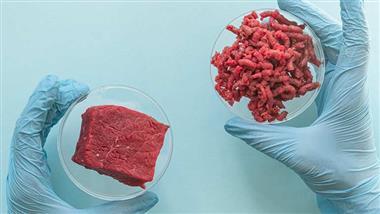by Dr. Joseph Mercola, Mercola:

STORY AT-A-GLANCE
- While the fake meat industry is being touted as an environmentally friendly and sustainable way to feed the world, the true intent is to recreate the kind of global control that Monsanto and others achieved through patented GMO seed development
TRUTH LIVES on at https://sgtreport.tv/
- Researchers at UC Davis warn there are major environmental downsides to lab-grown meat. According to their “cradle-to-gate life cycle” analysis, the lab-grown meat industry produces up to 25 times more CO2 than traditional animal husbandry, which nullifies the core ideological foundation upon which the industry is built
- Each kilo of cultured meat produces anywhere from 542 pounds (246 kilos) to 3,325 pounds (1,508 kg) of carbon dioxide emissions, making the climate impact of cultured meat four to 25 times greater than that of conventional beef
- At present, most cultured meat companies still use fetal bovine serum (FBS) as the growth medium, which is obtained from unborn calves that are cut out of the womb and drained of their blood while still alive. Hence, most claims of cultured meat being animal-free or free of animal cruelty are false
- Mission Barns is developing imitation bacon made from a mix of cultured meat, cell-cultured pork fat and pea protein. Have the pigs from which the cell samples are taken been treated with mRNA “vaccines,” and if so, is the cultured pork and pork fat safe to eat?
While the fake meat industry is being touted as an environmentally friendly and sustainable way to feed the world, the true intent is to recreate the kind of global control that Monsanto and others achieved through patented GMO seed development. In the end, lab-created meats are worse for the environment than livestock and will undoubtedly deteriorate human health to boot, just like GMO grains have.
Lab-Grown Meat Is Worse for Environment Than Cattle
As reported by the San Francisco Chronicle,1 researchers at UC Davis warn there are major environmental downsides to lab-grown meat that aren’t part of the conversation or the decision-making process.
According to their “cradle-to-gate life cycle” analysis,2,3,4,5 the lab-grown meat industry produces up to 25 times more CO2 than traditional animal husbandry, which nullifies the core ideological foundation upon which the industry is built.
As noted by the authors, investors have poured billions of dollars into animal cell-based meat (ACBM) sector based on the theory that cultured meat is more environmentally friendly than beef. But that hype is primarily based on flawed analyses of carbon emissions.
The primary sources of CO2 emissions are the purification processes, which require fossil fuels. The bacteria used to produce the “meat” releases endotoxins, and these must be eliminated from the growth medium or else the cells won’t reproduce properly. As noted by the authors:6
“Animal cell culture is traditionally done with growth medium components which have been refined to remove/reduce endotoxin. The use of these refinement methods contributes significantly to the economic and environmental costs associated with pharmaceutical products since they are both energy and resource intensive.”
Based on this assessment, each kilo of cultured meat produces anywhere from 542 pounds (246 kilos) to 3,325 pounds (1,508 kg) of carbon dioxide emissions, making the climate impact of cultured meat four to 25 times greater than that of conventional beef.
Sham Claims Based on Nonexistent Technologies
The UC Davis life cycle analysis also points out that several estimates of ACBM climate impacts are dependent on novel technologies that either do not exist yet or are unlikely to work.
For example, some have proposed growing cyanobacteria hydrolysate in open concrete ponds to then be “harvested, sterilized, hydrolyzed and used as an animal cell growth medium.” The problem is that this technology is not currently used, “nor is it one that is currently near feasibility,” the authors note.
In short, the claims propping up the cultured meat industry are a sham, as the idea that cultured meat is a greener option is based on nonexistent technologies rather than the technologies that are in use.



